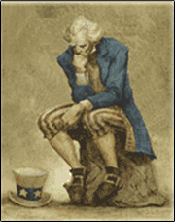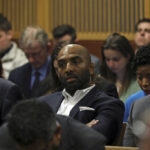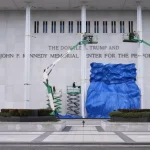
(function(d, s, id) { var js, fjs = d.getElementsByTagName(s)[0]; if (d.getElementById(id)) return; js = d.createElement(s); js.id = id; js.src = “https://connect.facebook.net/en_US/sdk.js#xfbml=1&version=v3.0”; fjs.parentNode.insertBefore(js, fjs); }(document, ‘script’, ‘facebook-jssdk’)); –>
–>
December 13, 2023
In the 1930s and ’40s, American leftism was spread out on a spectrum. At the far left end of the spectrum were the most radical of the leftists, communists, almost all of them members of the Communist Party (the CPUSA). At the right end of the spectrum were the most moderate of the leftists, liberal Democrats, supporters of Franklin Roosevelt and the New Deal. In between these two extremes were socialists, who were divided into two main groups, pro-communist and anti-communist. The former, even though for a variety of reasons they were unwilling to join the CPUSA, were generally sympathetic with the main ideas of communism, with the Soviet experiment, and with Comrade Stalin, who was presiding over that great experiment. The latter generally disapproved of Stalin’s dictatorship and disapproved of the CPUSA for making itself Stalin’s tool.
‘); googletag.cmd.push(function () { googletag.display(‘div-gpt-ad-1609268089992-0’); }); document.write(”); googletag.cmd.push(function() { googletag.pubads().addEventListener(‘slotRenderEnded’, function(event) { if (event.slot.getSlotElementId() == “div-hre-Americanthinker—New-3028”) { googletag.display(“div-hre-Americanthinker—New-3028”); } }); }); }
Since these four groups — (i) CPUSA, (ii) pro-Stalin socialists, (iii) anti-Stalin socialists, and (iv) liberal Democrats — were all together on the leftist spectrum, it was not surprising that pro-Stalin socialists might be influenced by communist ideas, and that anti-Stalin socialists might be influenced by the ideas of the pro-Stalin socialists, and that liberal Democrats might be influenced by the ideas of anti-Stalin socialists. Indirectly, then, and somewhat remotely, liberal Democrats could be influenced by communist ideas.
This seemed unobjectionable during the years of World War II, when the USA and the USSR were allies, when Stalin and FDR were friends of a sort. But when the war ended, when the alliance between the USA and the USSR ended, when Stalin controlled eastern Europe and threatened western Europe, when the Cold War settled in — when all this happened, many leading New Deal liberals (e.g., Harry Truman, Hubert Humphrey, Walter Reuther) judged that it would be politically unwise for the Democrat party to have any connection, no matter how indirect and remote, with the CPUSA. If the party and its moderate leftism were to have any future in a communism-hating America, a “wall of separation” would have to be erected between Democrat liberalism and any kind of leftism to the left of that.
And so the “wall” was erected. Democrats affirmed their patriotic hatred of communism. They created NATO and the Marshal Plan. They purged communists from American labor unions. They absolutely refused to attach the label “socialist” to any of their plans or policies, even though many of them could with justice be called socialistic. They dismissed as nonsense the common Republican charge that liberalism, correctly understood, is nothing better than “creeping socialism.”
‘); googletag.cmd.push(function () { googletag.display(‘div-gpt-ad-1609270365559-0’); }); document.write(”); googletag.cmd.push(function() { googletag.pubads().addEventListener(‘slotRenderEnded’, function(event) { if (event.slot.getSlotElementId() == “div-hre-Americanthinker—New-3035”) { googletag.display(“div-hre-Americanthinker—New-3035”); } }); }); }
Hence, in the second half of the 1940s, during the presidency of Harry Truman, the Democrat party made it clear that it was a party of nothing more dangerous than liberalism, which is to say moderate leftism. What’s more, it was a party whose liberalism, while sincerely dreaming of racial equality, was (at least for the time being) in electoral alliance with Southern racists and segregationists. It was the party of both racism and antiracism. The immediate task was to fight wicked communism abroad and benighted conservatism at home. The ideal of racial equality (an ideal all liberals shared, even though many of their fellow Democrats abhorred it) would have to be taken care of somewhere down the road.
Communism is no longer fashionable, at least in our part of the world. Those who would like to be radical leftists are no longer drawn, like iron filings attracted by a magnet, toward the communist ideal. But there are still those — especially among young people — who wish to be radical leftists. In a godless world, a world that is purely secular, a world that has rejected the possibility of a supernatural order of being, being a radical leftist is a way of being a post-Christian saint. And what earnest and good-hearted young person does not aspire to a kind of sainthood?
Just as in the 1930s and ’40s, there is a spectrum of leftism in the USA. At the extreme left end are the true revolutionaries, those prepared to work 12/7 on behalf of the revolution. There is no limit to what they might be willing to do. They despise American Jews because these Jews, like almost all Jews everywhere, sympathize with Israel, which the revolutionaries regard as being, like the USA, a nation of vile oppressors. If these true revolutionaries had happened to be with Hamas on October 7, they would have been willing to murder hundreds of Israelis. I doubt they would have been willing to rape Israeli women, but they would have stood aside as their Hamas comrades took care of that sadistic task.
In the middle of the spectrum are those who, too sensible or too timid to become true revolutionaries, are in sympathy with the would-be revolution. These are the young people who turn up at pro-Hamas or anti-Israel demonstrations. And these are the not so young professors who, in their quest for sainthood, sign collective letters that, de facto if not in so many words, condone terrorism and antisemitism.
At the right end of the spectrum are many liberal Democrats. They are not anti-Israel or anti-Jew or pro-Hamas or pro-terrorism, but they find themselves in an uncomfortable political alliance with multitudes who are in sympathy with all these forms of wickedness. For the middle-of-the-spectrum leftists — the privileged young people who take part in anti-Israel demonstrations and the privileged professors who write anti-Israel letters — are a significant part of the Democratic coalition.
The time has come for today’s liberal Democrats, these moderate leftists, to erect a “wall of separation” to cut themselves off from the extreme and middle sections of the leftist spectrum.

‘); googletag.cmd.push(function () { googletag.display(‘div-gpt-ad-1609268078422-0’); }); document.write(”); googletag.cmd.push(function() { googletag.pubads().addEventListener(‘slotRenderEnded’, function(event) { if (event.slot.getSlotElementId() == “div-hre-Americanthinker—New-3027”) { googletag.display(“div-hre-Americanthinker—New-3027”); } }); }); } if (publir_show_ads) { document.write(“
Image via Pxhere.
<!–
–>
<!– if(page_width_onload <= 479) { document.write("
“); googletag.cmd.push(function() { googletag.display(‘div-gpt-ad-1345489840937-4’); }); } –> If you experience technical problems, please write to [email protected]
FOLLOW US ON
<!–
–>
<!– _qoptions={ qacct:”p-9bKF-NgTuSFM6″ }; ![]() –> <!—-> <!– var addthis_share = { email_template: “new_template” } –>
–> <!—-> <!– var addthis_share = { email_template: “new_template” } –>




